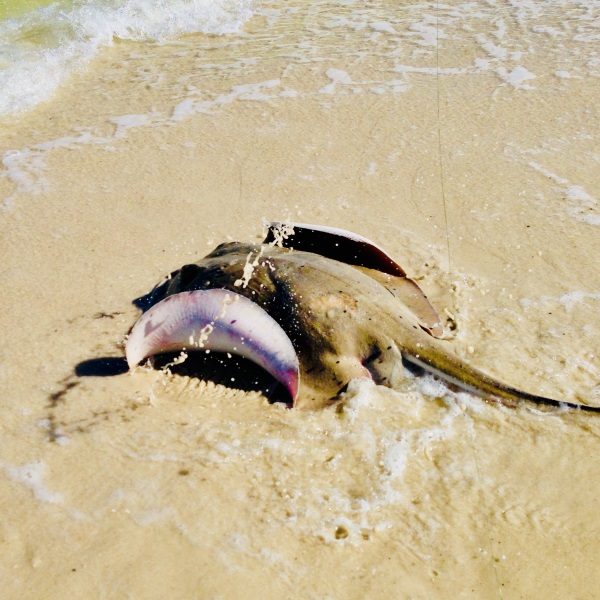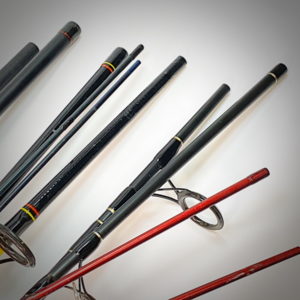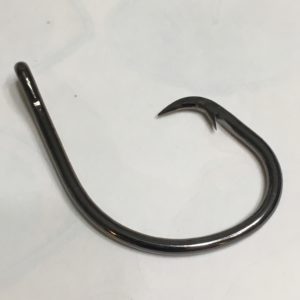
You may already know that you should shuffle your feet to avoid a stingray sting when fishing in the surf. By not stepping “down” onto a ray, you greatly reduce the chances of getting stung. But, what do you do to prevent getting stung when unhooking a stingray that you’ve caught?
There are 3 ways you can safely release a stingray. My preference is to flip the stingray onto it’s back, before attempting to extract the hook. Some people prefer, instead, to further reduce risk by cutting, or breaking, the stingray barb off before attempting hook removal. Finally, you always have the option to cut the leader near the hook.
I’ll discuss all 3 options in further detail below. Then, you can choose which one you are most comfortable using.
- Flip the stingray onto it's back
- Remove the barb
- Cut the leader
How To Unhook A Stingray And Avoid The Stingray Barb
The safest method of releasing a stingray is to simply cut the leader, and let the fish swim free with a hook in it’s mouth. That’s entirely acceptable, but not always necessarily the best thing for the stingray.
If you can release the ray without a hook in him, and with his defense mechanism still intact, that’s the ideal scenario for the fish.
Now, let’s discuss your 3 options for a successful release.
Fun Fact: Stingray Point, Virginia is named as such because Captain John Smith, the famous explorer who founded Jamestown, was stung by a stingray while fishing there.
Option 1 - Flip The Stingray On To It's Back
If possible, you should try to flip a stingray on to it’s back before attempting to remove the hook. This seems to calm the fish somewhat, and you’ll have the stinger mechanism pointed away from you.
Flipping a large stingray, however, is easier said than done. The one in the image above was one of the largest stingrays I have caught from shore. Due to it’s weight, and my lack of experience at the time, it was not easy for me to flip him over. Instead, I ended up cutting the leader, rather than further stressing the fish.
To flip a stingray, sometimes you can use the fishing line to flip him over. This works well for small stingrays. If that’s not possible, you can use a wet rag (or gloved hands) to cover, and wrap up the tail and barb together. Then, you should be able to firmly grasp the tail and barb at the same time in order to control the “danger zone”. While continuing to hold the tail and barb firmly, use your grasp of his tail to flip the stingray onto it’s back. .
Once the stingray is on it’s back, don’t let go of the tail. Use pliers or a de-hooking tool to remove the hook. Then, you can drag the ray into the water by continuing to hold the tail and barb.
Option 2 - Cut, Or Break The Stingray Barb Off
Some people prefer to break, or cut the stingray barb off before attempting hook removal. I only do that if I’m keeping a stingray for shark bait. The stinger is the ray’s defense mechanism, and although it will grow back, I don’t feel right about breaking it off.
Stingrays that you see in some aquarium petting tanks, have had their barbs removed on a regular basis. So, it must not be considered too barbaric to remove it.
A better option is to grasp the tail firmly with pliers, then slide a sharp knife between the tail and the barb. Cut towards the rays body while running your knife’s edge along the barb, while trying to angle it upwards toward the barb. When done properly, there shouldn’t be much blood at all, and it should come right off.
WARNING: Sometimes stingrays have more than 1 barb. So, just because you broke one off, doesn’t mean you are 100% in the clear. Check for the presence of other barbs before getting too careless.
Option 3 - Cut The Leader
If in doubt, or you don’t have the proper tools to release a stingray safely, just cut the leader as close to the hook as possible. The hook should rust out in short order.
I do this sometimes for large rays, as I think it’s probably less stressful on a heavier fish, than to drag them out of the water for a hook removal.
How A Stingray Sting Can Happen
Most stings occur because someone steps on a stingray in the water. However, many fishermen also get stung when attempting to unhook rays that they have caught while fishing.
The biggest danger zone when handling a stingray is above his back, at the base of his tail. But, they can sometimes reach a little further than you would think. You really have to be careful. You never want any part of your body above a ray and close to his tail.
Most stings I have seen (online) were the result of extreme carelessness.
Why A Stingray Barb Inflicts So Much Pain
The reason a stick from a stingray barb hurts so bad, is because the stinger literally contains venom. There is a venom gland in the skin of the tail, which keeps a sheath, or channel, along the barb loaded with poison. When the barb (or “stinger”) penetrates flesh, the venom is released into the body.
So, besides the pain of having a dagger-shaped bone jabbed into your body, the stingray’s neurotoxins pile on to your suffering. These toxins cause severe pain and swelling at the wound site, which grows worse with time.
What To Do If You Suffer A Stingray Sting
If you end up getting stung by a stingray, be prepared to respond quickly to minimize suffering.
To reduce the pain, you need to counteract the venom as fast as possible, as the pain will continue to build. Contrary to what you might think, don’t use ice to cool down the wound. Instead, clean the wound out, then submerge it in hot water. Hot water helps counteract, and break down the venom. So, you should submerge the wound in as hot of water as you can stand for approximately 30 minutes to an 1 1/2 hours. The water should be approximately 110 degrees Fahrenheit.
It’s best to seek medical attention, regardless if the stingray barb is still lodged in your body, or not. The doctor will be more able to remove the barb without causing excess tissue damage.
A stingray barb contains angled “teeth”, or barbs, that allows it to enter flesh quite easily. But, because of those angled barbs, it’s not going to come back out as easy as it went in – similar to a fish hook.
For more details on how to properly handle a stingray sting, refer to this WebMD article: Stingray Injury Treatment
Conclusion
Most of the videos I’ve seen, where fishermen get stung while unhooking stingrays, appear to be the result of carelessness. I think, as long as you exercise good common sense, and keep your hands away from the rear half of a stingray, you should be OK.
When in doubt, just cut the leader as close to the hook as possible.
Be careful out there!
Augustus Clay



